India’s 1st Digital Front of Pack Label Solution – 4 factors you cannot ignore to get your FOPL done
November 22, 2022
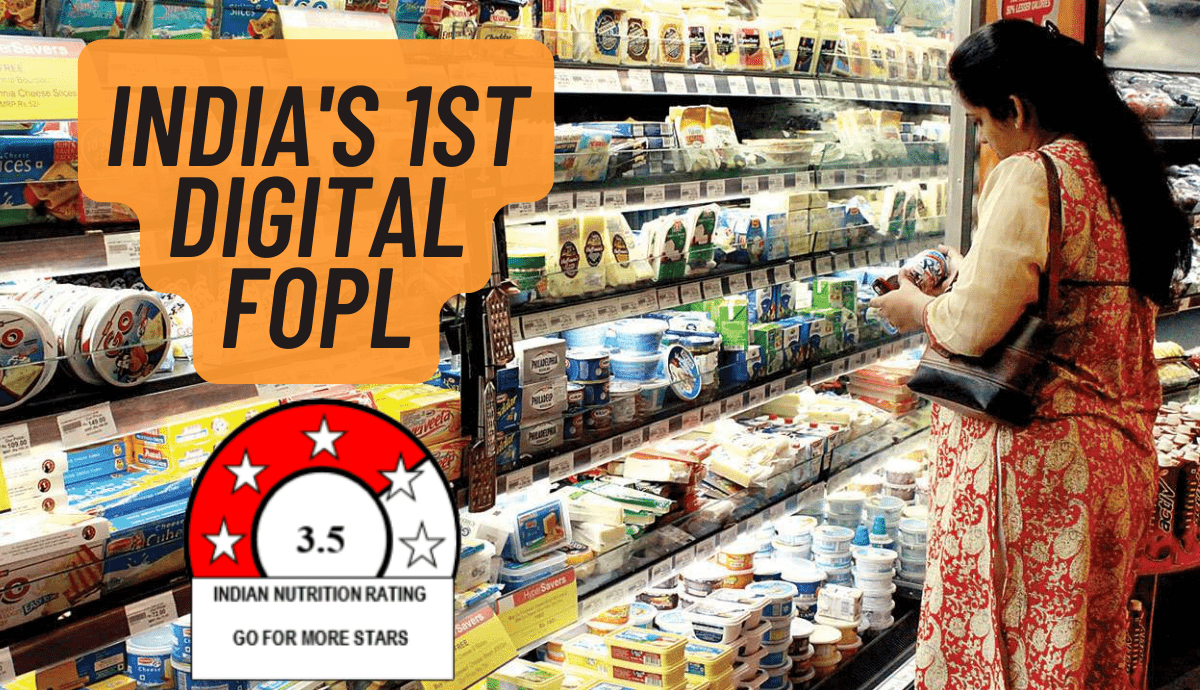
What is Front-of–pack labeling (FOPL)?
Indian Nutritional Rating (INR) system is introduced as the choice of Front-of-pack labelling (FOPL) by FSSAI, proposed in a draft released on 20/Sept/2022. The rating system is similar to the one that is currently used by the Bureau of Energy Efficiency for assessing the energy efficiency of electrical devices. INR FOPL will enable consumers to make better choices as the regulator clearly states more stars indicate a better food product. It is a guidance system for consumers which makes it easier for them to make a healthier decision without flipping the pack.
Calculation of INR score and star rating is dependent on–
Baseline points – are calculated using 4 health risk-increasing factors like energy, total sugars, saturated fat, and sodium for solid foods per 100g product, and using energy and total sugars for liquid foods per 100ml product.
FVNLM points- are calculated using a percentage of fruits, vegetables, nuts, legumes, and millet. For Liquid foods, only FV points are to be considered and not NLM points.
Protein and fibre points- which are calculated using protein and fibre amounts. For liquid foods, only protein points are to be considered and not fibre points.
The formula used to calculate INR scores is –

From the INR score, the correlated INR stars can be generated. The regulator has specified that the FOPL rating is voluntary for the first 48 months post the official regulation and will become mandatory thereafter. This means food manufacturers, be they FMCG giants or MSMEs need to be prepared to calculate INR for their existing products and products in pipeline projects. They need to calculate INR for products in the innovation pipeline to make changes if necessary to improve the ratings.
Additionally, FSSAI has also defined what HFSS foods are. High fat, sugar, salt (HFSS) food means a processed food product which has high levels of saturated fat or total sugar or sodium. The declared values of these ingredients are such that the product; does not satisfy the value of energy (kcal) from total sugar of less than 10 % of total energy, or from saturated fat of 10 % of total energy, and sodium of less than 1 mg/1 kcal.”
The regulations are voluntary for the first 48 months and mandatory thereupon. Responsible food companies would seek to build a first mover advantage by adopting FOPL standards on their product packs and strengthening transparency and trust with consumers.
Also Read - What is Front of Pack Labelling and why is it essential in India?
What are the 4 factors you cannot ignore to get your FOPL done?
Deciphering various components that determine the rating score and its formulae along with manual calculation can seem like a daunting task for any food manufacturer. That being said, it’s going to be of utmost importance from now on.
Here are the 4 key questions Food Business Owners are posed with for their business and how FOPL Digital Tool will help address them.
1. What is my product’s current INR Star Rating?
Digital FOPL solution will help users in getting easy and hassle-free INR calculations for their products. All they have to do is follow these 10 easy steps on the tool and you can have your INR score and rating in front of you. You are even ready to migrate the data to the FSSAI portal for you to download your INR star rating sticker. i. Click on calculate your FOPL rating.

ii. Select the relevant business and brand from the drop-down options. iii. Select the food category based on the Indian Food Category (IFC) for your product. iv. Food or Beverage selection will be pre-filled as per the FSSAI FOPL Regulations. v. Add the Food name and the variant for the same. vi. Add the serve size and unit.

vii. Add ingredients per 100g or ml of product using the dropdown selection. Add the quantities for each ingredient. You can even choose compound ingredients from the exhaustive database.

viii. The tool will calculate the fruit, vegetable, nut, legume, and millet content from the ingredient list provided by you.
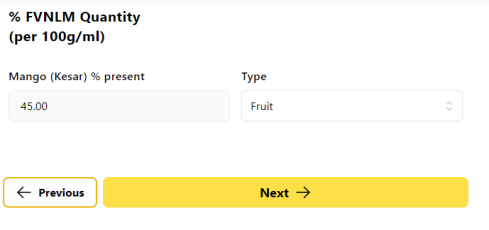
ix. Add the nutrient information for all 11 mandatory nutrients per 100g or ml of product.
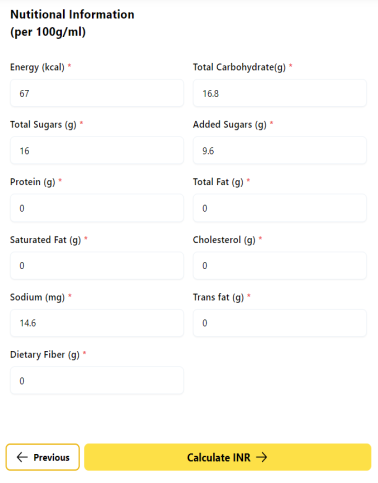
x. Click on Calculate INR and get directed to the results page.
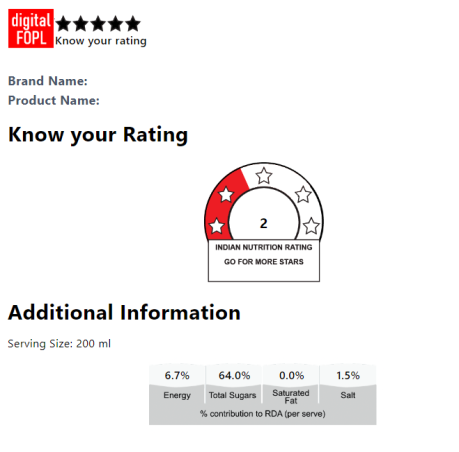
2. What constitutes the Star Rating?
In order to throw light on this question, the results page will also display the breakup of the star rating. This will help the user get a better perspective of the rating that they get. The INR rating will accompany its score, baseline scores for energy, saturated fat, sugar, and sodium along with FV points, NLM points, protein points and fibre points
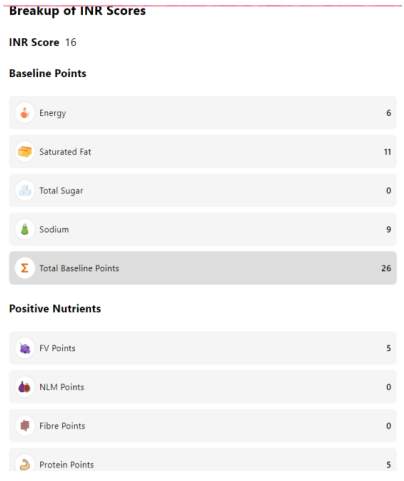
3. What is the category INR? (How does my INR compare to that of the product category?)
Digital FoPL has a unique feature that allows the FoPL INR Rating of a Product to be assessed against the INR Rating of the Respective Category. The category rating is an indicative average rating of products operating in the same category, based on a representative database of products. The Benchmarking Feature is a Starting Point for Food Companies on their FoPL journey.
4. How can a food company improve the INR score?
The Breakup of the INR Star Rating Score and Star Rating Benchmark are Features that are important pieces of information for Food Companies to know the Relative Rating of their Products on multiple Assessment Parameters. These features on Digital FoPL will help users know the Gap Analysis to Strengthen the Product Attributes that will Guide Product Re-formulation to Improve INR Star Rating.
The algorithm behind the tool is built to cater to user convenience leaving the user with enough information and direction to steer product development and evidence-backed marketing. It acts as a playground for food manufacturers, nutrition and regulatory teams, which has the potential of becoming an absolute necessity for a product launch or revamp
Also Read - Why Is It So Critical To Read A Food Label?

Sonika Sharma (MSc Food & Nutrition)
Sonika has worked with FMCGs as a market nutritionist for over 4 years. Apart from her interest in everything food and nutrition, she also enjoys reading and travelling.
